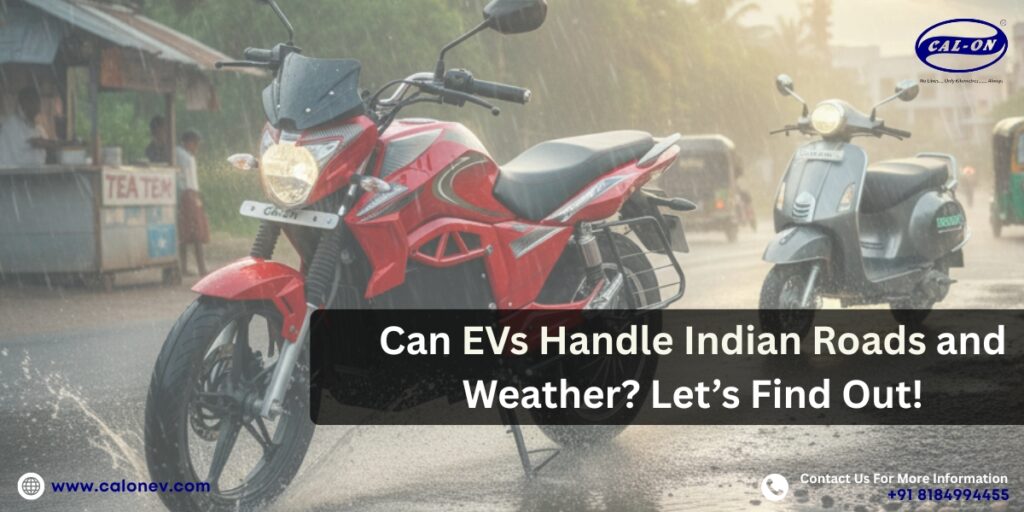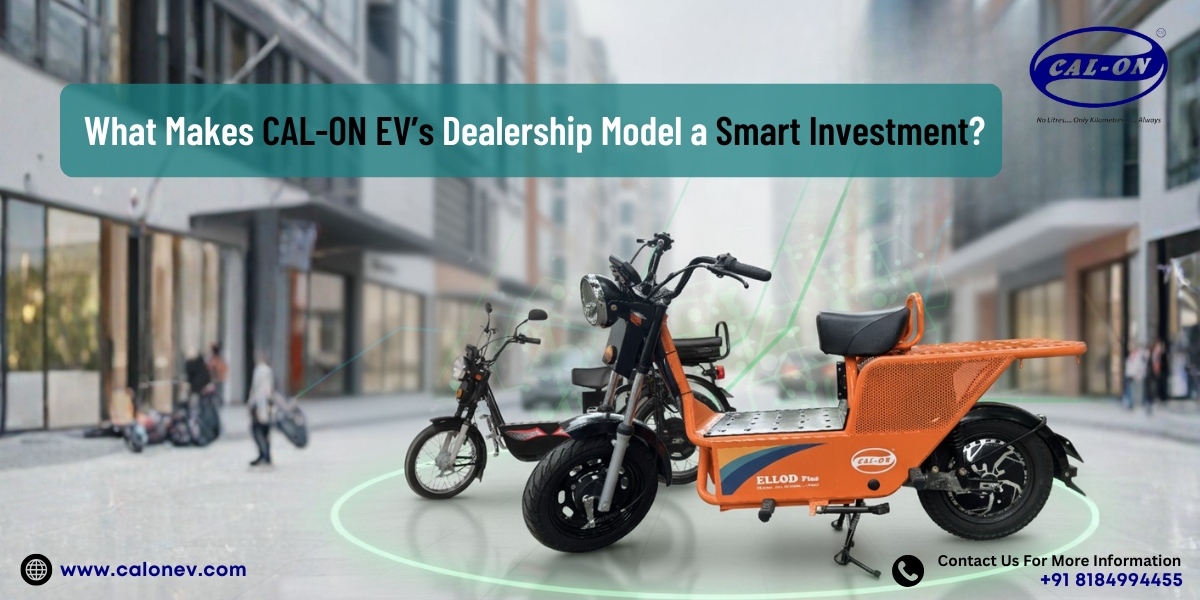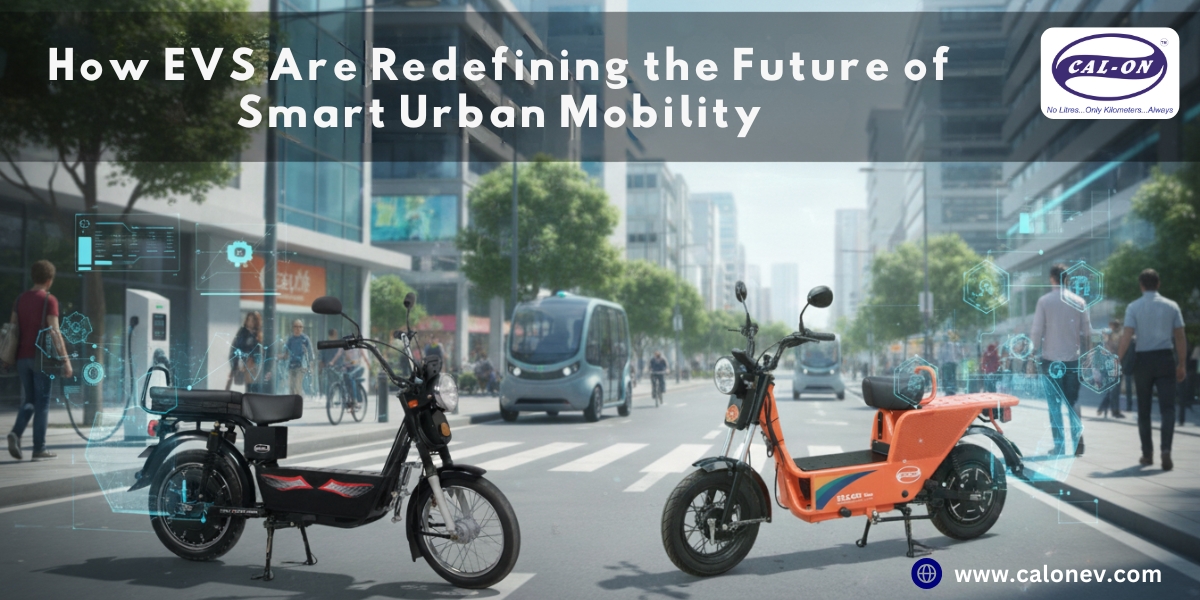EVs in India: Redefining Mobility in a Challenging Terrain
The question many potential EV buyers ask is: Can EVs handle Indian roads and weather? The short answer: absolutely – but it requires a deeper understanding of EV performance in Indian weather, durability, and the unique challenges posed by our traffic and climate. EVs in India are no longer just urban novelties. With increasing adoption, improving infrastructure, and technology tailored to Indian conditions, electric vehicles in India have proven their ability to perform efficiently even under hot, humid, and monsoon conditions.
At CAL-ON EV, we design vehicles specifically for EVs on Indian roads, ensuring long-term reliability, battery life in India, and superior handling in Indian traffic conditions. This blog explores how EVs cope with Indian roads and weather, what measures are taken to ensure durability, and how CAL-ON EV is shaping the future of sustainable transport in India.
Challenges of Indian Roads and Weather for EVs
India presents a unique combination of conditions that test any vehicle:
- Hot and humid summers in cities like Hyderabad, Chennai, and Mumbai
- Heavy monsoon rains across coastal regions
- Uneven roads, potholes, and variable traffic conditions
- Long commuting distances and unpredictable traffic congestion
For electric vehicles in India, these factors influence EV performance in monsoon and heat, battery efficiency, and overall long-term EV performance.
Understanding these challenges is critical to ensure EV road handling in India is reliable and sustainable.
EV Performance in Indian Weather: Hot and Humid Conditions
1. Heat Tolerance and Battery Efficiency
High temperatures can affect EV battery life in India if not properly managed. Modern EVs, including CAL-ON EV electric scooters and cars for Indian roads, use advanced battery management systems (BMS) that regulate temperature, ensuring long-term EV performance even in scorching heat.
- Battery cooling technologies maintain optimal efficiency
- Thermal insulation protects the battery from extreme temperature fluctuations
- Heat-resilient components ensure consistent EV performance in Indian weather
This ensures that EVs in India can be driven daily in cities like Delhi or Jaipur without performance degradation or risk to battery health.
2. Handling Monsoon and Wet Roads
India’s monsoon season poses unique challenges for EVs:
- Slippery and waterlogged roads
- Short-term voltage fluctuations affecting charging points
- Increased risk of corrosion if components are exposed
CAL-ON EV ensures all vehicles have IP-rated water-resistant motors, sealed electronics, and durable bodywork for EV performance in monsoon and heat. Drivers are also advised to follow electric vehicle road handling tips during wet conditions, such as:
- Moderate speed over waterlogged areas
- Avoiding deep puddles
- Using regenerative braking carefully
Such measures ensure EVs on Indian roads remain safe and reliable year-round.
EV Durability on Indian Roads
1. Suspension and Road Handling
The condition of Indian roads varies greatly between urban highways and rural routes. Electric scooters and cars for Indian roads must have robust suspension and chassis designs to handle potholes and uneven surfaces.
- CAL-ON EV vehicles are tested under rigorous road conditions across India
- Shock-absorbing suspensions improve EV road handling
- Sturdy build ensures long-lasting durability and reduces EV maintenance in India
This allows EVs in India to sustain long-term EV performance without frequent mechanical issues.
2. Battery Life in Indian Conditions
Battery life is central to electric vehicle durability. Factors affecting it in India include temperature, usage frequency, and charging habits. CAL-ON EV vehicles use high-quality lithium-ion batteries optimized for EVs in hot, humid, and monsoon conditions.
Key points for maintaining battery life in India:
- Avoid extreme charging habits; follow manufacturer guidelines
- Limit prolonged exposure to direct sunlight for parked EVs
- Use regular preventive maintenance to ensure peak performance
Following these practices ensures a sustainable transport experience in India.
EV Infrastructure and Charging Challenges in India
1. Charging Networks and Accessibility
While EVs in India are increasingly popular, Indian EV infrastructure is still developing. Limited public EV charging stations in urban and rural areas can affect convenience for new EV buyers.
CAL-ON EV addresses this challenge with:
- Easy home charging solutions
- Fast charging compatibility for urban routes
- Partnerships with public charging networks to expand access
This ensures EV range in Indian conditions is sufficient for daily commutes without compromising performance.
2. Dealing with Range Anxiety
A common concern is whether EVs in India can cover long distances, especially on highways or rural routes. Modern electric vehicle road handling tips include:
- Pre-planning routes near charging stations
- Maintaining optimal tire pressure and battery health
- Using eco-modes to extend EV range in Indian conditions
Such strategies allow users to confidently adopt sustainable transport in India.
Handling Indian Traffic with EVs
1. Stop-and-Go Traffic Efficiency
Indian cities are infamous for congested streets. EVs excel in stop-and-go traffic because electric motors are highly efficient in low-speed conditions, unlike traditional petrol engines.
- Instant torque improves maneuverability in traffic
- Regenerative braking recovers energy in frequent stops
- Smooth acceleration reduces driver fatigue
This makes EVs on Indian roads highly suitable for daily urban commuting.
2. Safety and Stability
Handling Indian traffic requires vehicles that are not just efficient but also safe and stable. CAL-ON EV vehicles incorporate:
- Anti-slip braking systems
- Reinforced frame for crash safety
- Smart handling for sharp turns and uneven road surfaces
These features enhance EV road handling in India while improving rider confidence.
Maintenance and Long-Term Performance of EVs in India
1. Low Maintenance Compared to Petrol Vehicles
One of the advantages of Electric Vehicles in India is lower maintenance:
- Fewer moving parts
- No oil changes required
- Minimal wear on brakes due to regenerative braking
This reduces EV maintenance costs in India and enhances long-term EV performance.
2. Regular Preventive Maintenance
For optimal performance, EV owners should follow simple electric vehicle road handling tips:
- Check battery health regularly
- Clean and inspect electrical components during the monsoon
- Monitor tire and suspension condition
These measures ensure EV durability in diverse Indian weather conditions.
Government Incentives Supporting EV Adoption
The Indian government promotes EV adoption with incentives in India:
- FAME II subsidies for buyers and charging infrastructure
- Tax rebates on electric vehicles
- Incentives for setting up EV charging stations in urban areas
These incentives make EVs in India more affordable and accessible, encouraging sustainable mobility.
CAL-ON EV: Built for Indian Roads and Weather
CAL-ON EV has designed vehicles keeping EV performance in Indian weather at the core:
- Weather-resistant design for hot, humid, and rainy climates
- Durable suspensions for potholes and uneven roads
- Efficient battery management systems for heat and monsoon conditions
- Urban-friendly design for handling traffic and tight roads
By combining durability, performance, and safety, CAL-ON EV ensures long-term EV performance for Indian users.
Conclusion: EVs Are Ready for India’s Roads and Climate
The era of EVs in India is here – and these vehicles are equipped to handle the unique challenges of Indian roads and weather. From hot summers to monsoon rains, EV performance in Indian weather is reliable, safe, and sustainable.
At CAL-ON EV, we are committed to providing vehicles that offer long-term Electric Vehicle performance, low maintenance, and seamless electric vehicle durability on Indian roads. With supportive government policies, growing infrastructure, and technological innovation, EVs in India are not just a possibility – they are the future of urban mobility and sustainable transport in India.
CAL-ON EV: Driving India’s sustainable future, one reliable ride at a time.
>> Also Read: CAL-ON EV Dealership Investment: A Gateway to Profitable Opportunities
Frequently Asked Questions (FAQs)
1. Can EVs handle Indian hot and humid conditions?
Yes. Modern EVs, including CAL-ON EV, use advanced battery management systems and heat-resistant components for reliable performance in Indian weather.
2. Are EVs suitable for monsoon conditions in India?
Absolutely. Water-resistant motors and electronics ensure safe performance, while following electric vehicle road handling tips enhances safety.
3. How long do EV batteries last in India?
With proper maintenance, EV battery life in India typically ranges from 4–6 years, with gradual efficiency degradation depending on climate and usage.
4. How do EVs perform in Indian traffic?
EVs excel in stop-and-go traffic due to instant torque, regenerative braking, and smooth acceleration, making EVs on Indian roads ideal for urban commuting.
5. Are EVs low-maintenance compared to petrol vehicles?
Yes. EV maintenance in India is simpler and cheaper because EVs have fewer moving parts, no fuel system maintenance, and longer-lasting brakes.
6. Do government incentives help Electric Vehicle adoption in India?
Yes. Programs like FAME II and tax rebates support buyers and infrastructure, making Electric Vehicles in India more accessible and cost-effective.
Follow Us on Social Media! Stay Connected & Stay Ahead!











